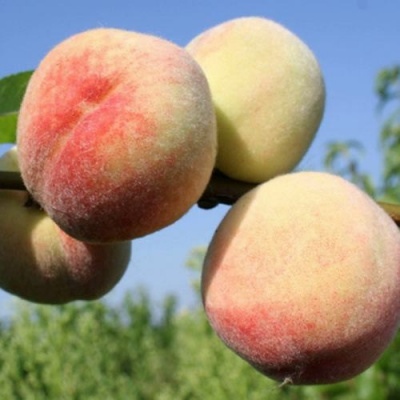
- Authors: A.I. Sychov, L.I. Taranenko, V.V. Yarushnik (Donetsk Experimental Gardening Station)
- Growth type: vigorous
- Ripening period: mid-late
- Self-fertility: self-fertile
- Appointment: for fresh consumption, for canning
- Yield: fruitful
- Marketability: high
- Transportability: low
- Early maturity: in the third year
- Bone size: medium size
The Donetsk white peach variety was bred at the Donetsk experimental gardening station. The variety was able to quickly gain popularity among gardeners. The variety is grown both for fresh consumption and for canning.
Description of the variety
This species is considered vigorous. His crown is dense and round. The tree is fast growing. Its maximum height is 3-4 meters. Shoots are light green in color. Their thickness is average. Plants have excellent frost recovery.
The foliage is quite large. Her color is dark green. There are small denticles at the edges of the leaves. The early maturity of the variety is average.
The flowers on the tree grow rather large, pink in color. The petals are slightly bent upward. They begin to open even before the leaves appear. The buds have a pleasant aroma.
Fruit characteristics
The fruits of this variety are of medium size. Their color is snow-white. On the sunny side, there will be a dark red cover. The shape of the fruit is round or round-oval with a small seam. Each fruit weighs 100-110 grams.
Slight pubescence can be seen on the surface of the peaches. The color of the pulp is white, translucent. She's pretty juicy. The bones are medium in size, they are not detachable. Ripe fruits have a pleasant aroma.
The transportability of the fruit is very low, as it is quite easy to damage them, after which dark spots will begin to form on the surface. The keeping quality of peaches is also low.
Taste qualities
Peaches have a sweet taste with a slight sourness. Fresh fruit tasting score was 4.2-4.4 points. Fruits of this variety are often used in the preparation of preserves, jams, homemade marmalade. And also they can be dried.
Ripening and fruiting
Trees begin to bear fruit in the 3rd year after planting in the ground. Ripening period is medium late. The fruiting period begins in the second or third decade of August.
Yield
The Donetsk white variety is considered to be fruitful. Average yield from one healthy and mature tree is 50-60 kilograms of fresh fruit.
Growing regions
Donetsk white peaches are most common in households in the Donbass and the neighboring regions of Ukraine and Russia. In addition, the variety can be seen in the Lugansk and Rostov regions.
Growing and caring
It is best to plant this crop on medium loamy soils with good air exchange and moisture exchange with a neutral or slightly alkaline reaction. The place should be sunny and well protected from the wind.
When planting, you must maintain a distance of 3 meters from the nearest buildings and other plants. It is not recommended to plant plants in places where nightshade and melons and clover were recently grown.
If you plan to plant in the spring, then the planting holes should be prepared in the fall.A support is placed in the middle, most often pegs. The seedlings are lowered into the holes and covered with earth. During the season, trees are watered 3-5 times.
It should be noted that the Donetsk white variety is self-fertile. Plants can be pollinated with pollen of their own variety. In the first 4 years of life, formative pruning is carried out. In this case, a bowl-shaped crown is formed.
As top dressing, the same fertilizers are most often used as for most other varieties of this culture: humus, bird droppings, compost. And also superphosphate, potassium chloride, urea, borax are used.



Frost resistance and the need for shelter
Despite its high frost resistance, the Donetsk white variety still needs to be prepared for winter. To do this, the soil around each tree is mulched with humus or peat. And also they can be insulated using cardboard or a frame. Before wintering, the plant must be watered well (there are about 10 liters of water per 1 square meter).
Disease and pest resistance
This variety has an average resistance to diseases and pests. It is often affected by powdery mildew, curliness. In any case, the damaged parts are pre-cut from the plant.
After the end of flowering, diseased trees are treated with Topaz or Topsin preparations. Bordeaux liquid can also help against curliness. In addition, the vegetation often infects aphids. If the damage is too strong, then the trees are treated with chemicals ("Karbofos"). Various insecticides can be used to control aphids and other harmful insects.

































































